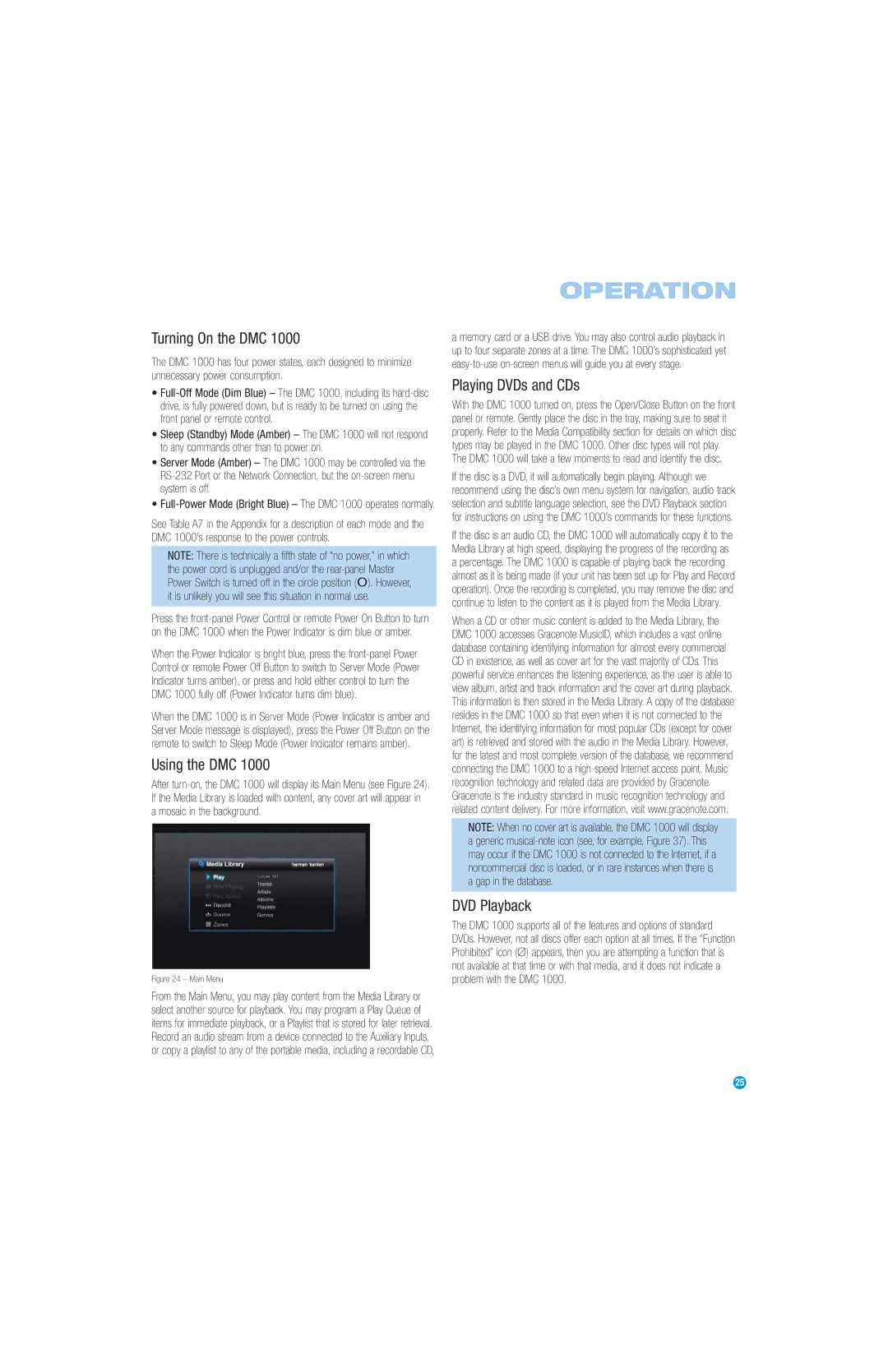
OPERATION
Turning On the DMC 1000
The DMC 1000 has four power states, each designed to minimize unnecessary power consumption.
•
•Sleep (Standby) Mode (Amber) – The DMC 1000 will not respond to any commands other than to power on.
•Server Mode (Amber) – The DMC 1000 may be controlled via the
•
See Table A7 in the Appendix for a description of each mode and the DMC 1000’s response to the power controls.
NOTE: There is technically a fifth state of “no power,” in which the power cord is unplugged and/or the
Press the
When the Power Indicator is bright blue, press the
When the DMC 1000 is in Server Mode (Power Indicator is amber and Server Mode message is displayed), press the Power Off Button on the remote to switch to Sleep Mode (Power Indicator remains amber).
Using the DMC 1000
After
Figure 24 – Main Menu
From the Main Menu, you may play content from the Media Library or select another source for playback. You may program a Play Queue of items for immediate playback, or a Playlist that is stored for later retrieval. Record an audio stream from a device connected to the Auxiliary Inputs, or copy a playlist to any of the portable media, including a recordable CD,
a memory card or a USB drive. You may also control audio playback in up to four separate zones at a time. The DMC 1000’s sophisticated yet
Playing DVDs and CDs
With the DMC 1000 turned on, press the Open/Close Button on the front panel or remote. Gently place the disc in the tray, making sure to seat it properly. Refer to the Media Compatibility section for details on which disc types may be played in the DMC 1000. Other disc types will not play. The DMC 1000 will take a few moments to read and identify the disc.
If the disc is a DVD, it will automatically begin playing. Although we recommend using the disc’s own menu system for navigation, audio track selection and subtitle language selection, see the DVD Playback section for instructions on using the DMC 1000’s commands for these functions.
If the disc is an audio CD, the DMC 1000 will automatically copy it to the Media Library at high speed, displaying the progress of the recording as a percentage. The DMC 1000 is capable of playing back the recording almost as it is being made (if your unit has been set up for Play and Record operation). Once the recording is completed, you may remove the disc and continue to listen to the content as it is played from the Media Library.
When a CD or other music content is added to the Media Library, the DMC 1000 accesses Gracenote MusicID, which includes a vast online database containing identifying information for almost every commercial CD in existence, as well as cover art for the vast majority of CDs. This powerful service enhances the listening experience, as the user is able to view album, artist and track information and the cover art during playback. This information is then stored in the Media Library. A copy of the database resides in the DMC 1000 so that even when it is not connected to the Internet, the identifying information for most popular CDs (except for cover art) is retrieved and stored with the audio in the Media Library. However, for the latest and most complete version of the database, we recommend connecting the DMC 1000 to a
NOTE: When no cover art is available, the DMC 1000 will display a generic
DVD Playback
The DMC 1000 supports all of the features and options of standard DVDs. However, not all discs offer each option at all times. If the “Function Prohibited” icon (Ø) appears, then you are attempting a function that is not available at that time or with that media, and it does not indicate a problem with the DMC 1000.
25
